Magnolia ‘Teddy Bear’ is an evergreen tree, which grows upright and can reach between 3-6m in height depending on conditions. It grows tight and compact, making it a wonderful tree for an informal hedge or screening plant. It has large and rounded leaves which are dark geen and glossy on top, with a felted bronze underside.
The Magnolia grandiflora ‘Teddy bear’ produces large white flowers during the warmer months from late spring through to autumn.
Magnolias have long been a popular choice as ornamental trees in Australia. Teddy Bear Magnolia is a fantastic cultivar of Bull Bay Magnolia that grows smaller and more compact.
This stunning specimen tree can stand alone in any garden with its large oval-shaped shiny green leaves and perky upright growing habit. This easy-going plant is a must-have for those looking for a decorative tree for their outdoor spaces.
Here is everything you need to know to grow and care for your Magnolia ‘Teddy Bear’.
More...
Family: | Magnoliaceae |
|---|---|
Genus: | |
Species: | M. Grandiflora |
Cultivar: | ‘Teddy Bear’ |
Common Names: | Southern Magnolia, Bull Bay Magnolia |
Location: | Outdoor |
Type: | Evergreen tree |
Growth: | 3 to 6 metres tall, 2 to 3 metres wide |
Sun Requirements: | Full sun to part shade |
Foliage Colour: | Green |
Flower Colour: | Creamy-white |
Flowering: | Early spring through summer |
Fruit: | Small berry-like fruit followed by seeds in autumn |
Maintenance Level: | Low |
Poisonous for Pets: | Non-toxic to cats and dogs |
Introducing Magnolia ‘Teddy Bear’
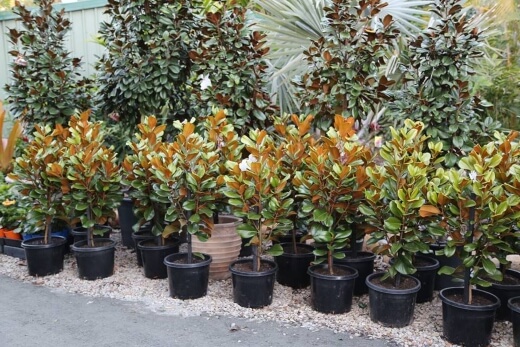
Source: oxleynursery.com.au
When flowering, this tree produces large and fragrant creamy-white cup-shaped flowers that form as upright blooms atop the tree’s luscious large evergreen foliage.
The dark-green leaves also shine brilliantly with coppery-red undersides and brilliant new growth. With so many attractive features, it's no wonder this cultivar has become one of the most popular choices of Magnolia trees.
Magnolia ‘Teddy Bear’ is a more recent cultivar of Magnolia grandiflora and belongs to the Magnoliaceae family like much of its genus. This smaller growing cultivar features a denser growing habit that stays tight and tidy as the tree develops.
Widely popularised for its attractive foliage and flowers, this tree will bloom on and off throughout the year in the right conditions. In warmer, subtropical to tropical regions, this tree is considered fast-growing. In cooler areas, growth can be more moderate.
Most trees will reach about 3 to 6 metres tall and 2 to 3 metres wide in cultivation. This cultivar can be used in any sized garden as a feature tree outside, either in your garden bed, pots, or plant stands but it can also be used as an attractive screening plant, shade tree or windbreak.
How to Grow Magnolia ‘Teddy Bear’
Since this plant is a hybrid cultivar, true to type young and healthy plants will need to be purchased from reputable local nurseries or online vendors. Small tubestock plants or seedlings can then be transplanted into your landscape.
Alternatively, as with most broadleaf evergreen trees, this plant can be propagated using cuttings taken in summer after the current season’s growth has started maturing.
Cuttings will ensure you grow a true to type version of the parent plant and they will also grow and produce flowers much faster than seedlings.
Magnolia grandiflora ‘Teddy bear’ Propagation

Source: oxleynursery.com.au
Propagating Southern Magnolia Using Cuttings
- Take cuttings in late summer after the buds have set.
- Using a sharp and sterile knife or secateurs, cut semi-hardwood stems or branches from your tree that are about 15 to 20cm in length.
- Place your cuttings in water immediately after cutting them away while you prepare your containers.
- Prepare propagation containers filled with rich, quality potting soil or moist perlite. The soil must be well-draining and your containers should also feature drainage holes.
- Gently remove all but the upper leaves from each cutting and then make a 5cm vertical slice in the stem ends.
- Dip each stem end into some rooting hormone and plant the cuttings into your containers.
- Place them in a warm location that gets indirect light. You can help with humidity levels if needed by placing each container into a plastic bag.
- Mist frequently and keep the potting mix slightly moist.
- New growth should appear within a few months.
- Let your cuttings establish themselves for a couple more months before transplanting them into their forever homes.
It is important to note that propagation using cuttings is not always the most reliable way to grow this tree and does require a little luck sometimes. Should you not succeed the first time, you can always try again in the following years.
Magnolia ‘Teddy Bear’ Root Considerations
Magnolia trees produce large but shallow roots that can be sensitive to damage, especially during development. Try to avoid mowing or using a weed eater beneath your Teddy Bear to help avoid any potential damage.
For added protection and general health, you can add a 10 to a 15-centimetre layer of organic mulch around the base of the tree in summer. The roots are also known to be quite extensive in magnolia trees, growing horizontally across the ground rather than vertically.
They can extend about three times further from the trunk than the canopy’s width, hence why it can be difficult to transplant established trees. Be sure to select an appropriate planting site to allow enough room for the tree and its roots to comfortably spread as needed while it reaches its mature size.
Planting Magnolia ‘Teddy Bear’
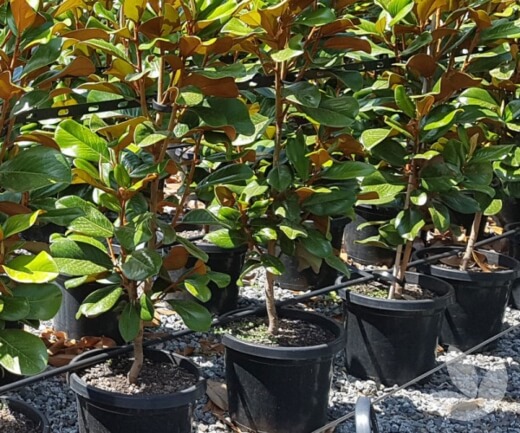
These trees can easily integrate themselves into most garden settings and sizes. Whether planted alongside companions or used as a stand-alone feature tree outside, this special cultivar will need a few basic growing conditions to thrive and bloom prolifically. Planting should be done in spring to early summer.
Ideal Sun for Magnolia ‘Teddy Bear’
Full sun is preferred but this tree will also be able to grow and thrive in partly shaded positions. It is recommended that this plant receives about 5 to 6 hours of sun each day. A lack of sufficient light will cause poor growth.
Best Soil to Use
For container-grown plants, a quality potting mix or perlite mixture should work great. For garden beds, a mixture of sandy-loam soil with some compost mixed in is best. The soil must be well-draining to prevent the roots from sitting in water.
Plant Spacing for Magnolia ‘Teddy Bear’
Spacing in Beds
For general bed spacing, it is advised to plant Magnolia ‘Teddy Bear’ about 2 to 5 metres apart from other trees if you intend on growing multiple specimen trees next to each other.
Be sure to also plant these trees about 15 metres away from your house or paving to ensure you don’t run into any issues as the tree matures.
Ideal Hedge Spacing
For establishing a healthy and dense hedge using Magnolia ‘Teddy Bear’, space the plants around 1.5 metres apart for optimal growing room.
How to Plant Magnolia ‘Teddy Bear’
Planting Magnolia ‘Teddy Bear’ in the Garden
- Choose a spot that gets full sun to part shade.
- Clear any grass or ground-covering plants from around the planting area to about 1 metre across.
- Dig some quality compost and a slow-release fertiliser into the soil to create a healthy mixture for growth.
- Using a spade or shovel, dig a planting hole that is twice as wide and to the same depth as the plant's current container.
- Carefully remove the plant from its current container with care. Magnolias don’t respond well to root disturbances.
- Gently place and position the plant into your planting hole and gently backfill with soil, lightly firming down once the plant is snug.
- Always water well after planting to settle the roots in the soil.
- Help keep the soil moist for the first several weeks while the plant establishes itself in its new home.
- Mulch with an organic mulch around the base of the plant, being careful not to mulch too close to the main trunk.
- Depending on your weather conditions, you may need to water deeply about once to twice per week while the tree grows.
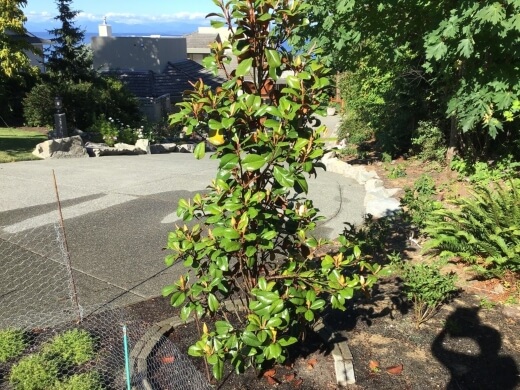
Source: forum.comoxvalleyhortsociety.ca
Growing Magnolia ‘Teddy Bear’ in Pots
- Choose a pot that is at least twice the size of the root ball of your plant.
- Prepare your pot with a quality, rich potting mix that retains healthy amounts of moisture.
- Gently remove your plant from its current container, taking care not to disturb the roots too much.
- Position your plant in the pot and backfill with soil, lightly firming it down once your plant is sitting comfortably.
- Water in well after planting.
- Position your pot in a location that gets enough sunlight.
- Provide your plant with a deep watering about twice a week depending on weather conditions. If there is sufficient rain, supplemental watering can be kept to a minimum.
- During flowering seasons, feed your potted Magnolia every 2 weeks or so to encourage bountiful blooms and dense new growth.
Magnolia ‘Teddy Bear’ Care Tips
Caring for these perky plants shouldn’t require much hassle at all, especially once they are established and actively growing. Thanks to their inherent tidy growing habits, these small trees tend to maintain themselves quite well in gardens.
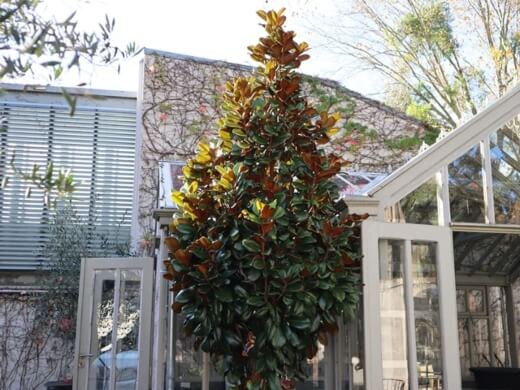
Source: parterre.com.au
Here are a few quick caring tips when growing your teddy bear.
Pruning Magnolia ‘Teddy Bear’
This tree may not need to be pruned at all and vigorous pruning is generally discouraged when dealing with this plant. Minor trimming may be needed in spring before new growth for small improvements to shape and density in preparation for the growing season.
Watering Routine
Deeply water your tree moderately once established. Extra supplementary water will be needed during the dry periods of the hot summer months when you can water deeply about once per week. If replanting, water in thoroughly and add some compost to the surrounding soil.
Fertilising Magnolia Grandiflora
During flowering seasons in spring, feed your tree with a general controlled release tree fertiliser to encourage healthy new growth and bigger blooms. Fertilising is especially important in poorer soils.
Common Pests, Problems & Diseases
Mealybugs/Scale Insects
As with many broadleaved outdoor plants, small scale insects or mealybugs could pose a minor issue from time to time, especially in the warmer months.
These bugs normally form on the undersides of leaves where you would notice small brown spots as well as foliage being damaged.
Luckily, these pests are easy to treat by spraying them and knocking them off of your foliage using soap and water. Alternatively, you can apply some neem oil or a similar horticultural spray to rid your plant of the infestation.
Browning Leaf Tips & Edges
This is a clear indication that your tree needs more water in the hot summer months. Be sure to stick to a regular and healthy watering routine and to check your soil moisture more frequently during summer.
Magnolia grandiflora ‘Teddy bear’ FAQs
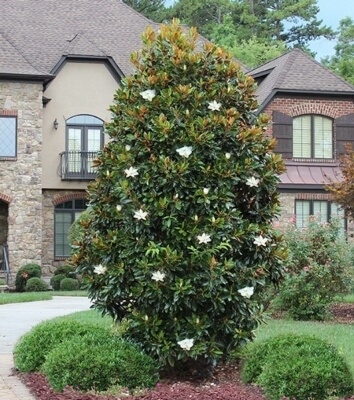
Source: palmnursery.com.au
What is the difference between Little Gem and Teddy Bear?
Little Gem Magnolia is a taller growing variety that also grows narrower than Teddy Bear. Teddy Bear magnolia tree creates a lower and wider canopy whereas Little Gem is more pyramidal.
Magnolia ‘Teddy Bear’ also features more attractive foliage according to many enthusiasts.
Can you keep Magnolia ‘Teddy Bear’ small?
The tree's dense foliage can lead to very heavy limbs. Be sure to prune your Teddy Bear annually in mid to late summer once it has stopped flowering. You can also thin out the crown to reduce limb weight and increase the airflow through the tree to enhance its appearance. To grow a smaller tree, it is best to rather grow it in a container.
How long do Magnolia ‘Teddy Bear’ bloom?
Flowers will usually begin in late spring and can continue through summer and into autumn in good growing conditions.
Where should you not plant a magnolia tree?
Generally, these trees do prefer full sun to light shade. However, if you live in a particularly warm or dry climate, your magnolia might benefit from some shade in the hot afternoon sun.
Be sure to also avoid very exposed and windy locations as strong winds can quickly damage larger flowers and brittle branches.
How often do you water a Magnolia ‘Teddy Bear’?
In good conditions, it is recommended to water deeply about 2 to 3 times a week. Soil and weather conditions can influence how much water your magnolia tree needs.
Are Teddy Bear Magnolias messy?
The flowers can shed a large number of petals while blooming and the seed pods can fall to the ground in late summer after flowering. Be sure to avoid planting your tree near any high-traffic areas like patios, pools or decks where the litter may become an issue.
You might also have to do some general garden clean-up each year after flowering to tidy up the area around your magnolia.
What grows under a Magnolia ‘Teddy Bear’?
Once matured with a full canopy, the ground below this tree may only receive dappled and indirect light. It is best to plant shade-tolerant plants underneath your magnolia.
Popular choices include:
Why does my Teddy Bear Magnolia tree not flower?
There could be two possible reasons for this. It could be that your tree isn’t receiving enough light, especially in the growing seasons. Magnolias flower best when given at least 3 to 4 hours of direct light each day.
The other reason could be an excess of nitrogen in your fertiliser causing a nutrient imbalance in the soil.
How fast do Magnolia ‘Teddy Bear’ grow?
This magnolia is a reletive fast grower of around 1 foot (30 centimetres) per year until it reaches it's maximum size of 6m.
For growing more Magnolia varieties, check out our guide on growing Magnolia ‘Black Tulip’ in Australia.
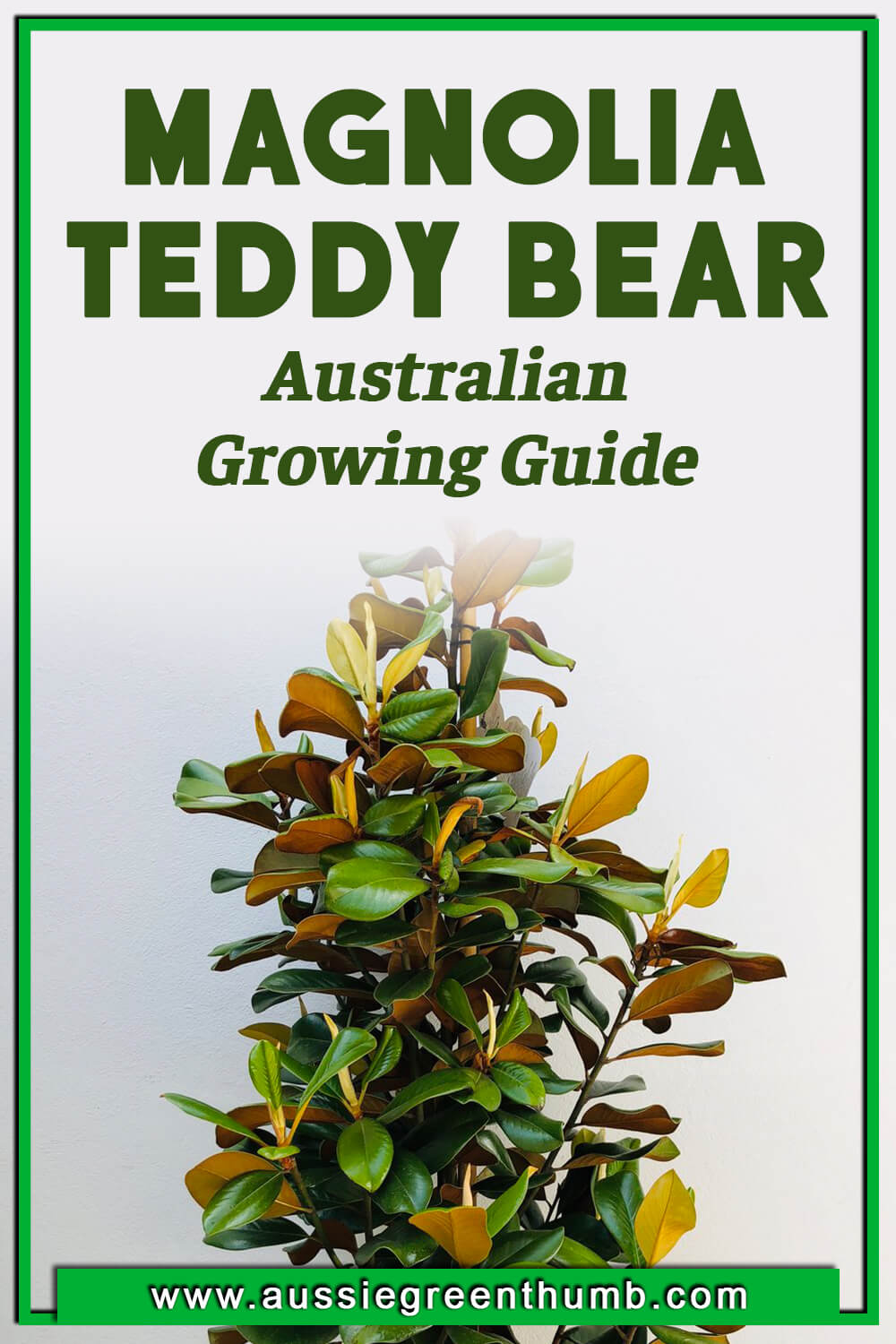
Elevate Your Landscape with the Evergreen Magnolia ‘Teddy Bear’
With effortless charm and all-around attractive features, this specially cultivated magnolia tree was made to be the perfect ornamental garden tree for any garden setting or size.
The delicate but profuse creamy white flowers sit comfortably atop glossy-green, large-leaved foliage that grows in a tidy and easy to manage way. Whether grouped as a decorative addition to your garden or used as a stand-alone feature plant, the Magnolia ‘Teddy Bear’ is easy to enjoy.
Published on January 29, 2023 by Maisie Blevins
Last Updated on April 7, 2024





What is the best privacy tree to plant with non-invasive roots? I have been looking at the Tibouchina and teddy bear magnolia
Hi Aurora,
Magnolia ‘Teddy Bear’ is definitely a good choice, and Tibouchina too, but they’re not very fast growing, and both are technically shrubs. Magnolias are easy to grow as trees, and are normally sold that way though, but Tibouchina might be quite shading.
Is there another boundary around the property, so the tree would be serving as a privacy screen from first floor windows, or are you thinking of something like Tibouchina to make sure it’s got privacy from the ground up?
If that’s the case, go for something simple like Crape Myrtle (Lagerstroemia), or another flowering Myrtle that will grow reasonably quickly and have an even denser, bushier effect
Best regards,
Maisie Blevins
Maisie, I have planted two Teddy Bears in large entry pots. Is it wise to cut the tops out to encourage denser growth?
Hi Billie,
I guess it depends on the shape you want them in the end, but I would usually advise against pruning Magnolias unless you’re removing damaged or disease branches. They can send up water shoots really quickly and it completely changes the shape of them.
But also, because they’re in those big entry pots, I’m guessing you’re not against having them as a manicured pair? If that’s the case, then yes, go ahead and prune them.
It’s not like pruning Buxus, where you just shear it all, but if you prune everything that gets to the size/shape you want, you can restrict them. And then, once a year, go around and snip out the new growth by about two nodes, or back to a fork. After a couple of years they can be half-formal, half-shaggy, and packed with character.
Good luck!
Maisie Blevins